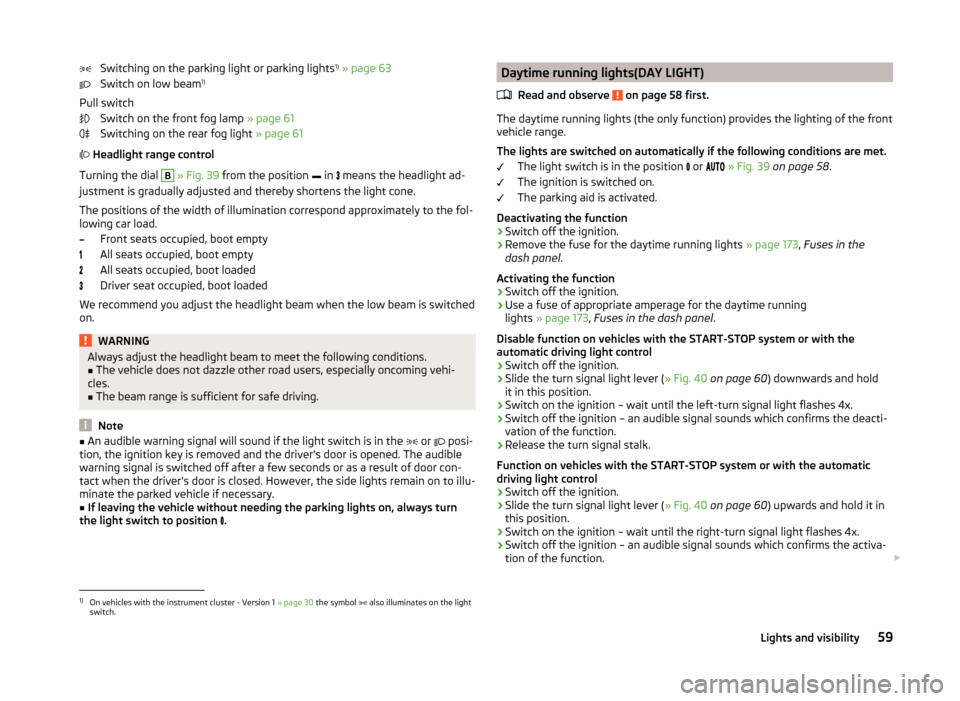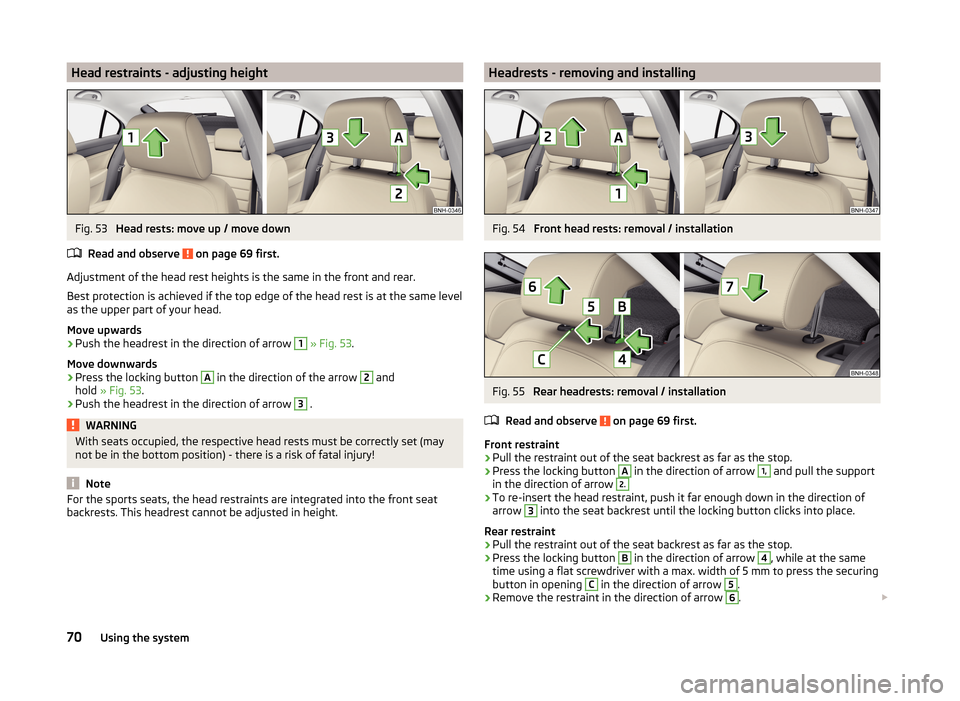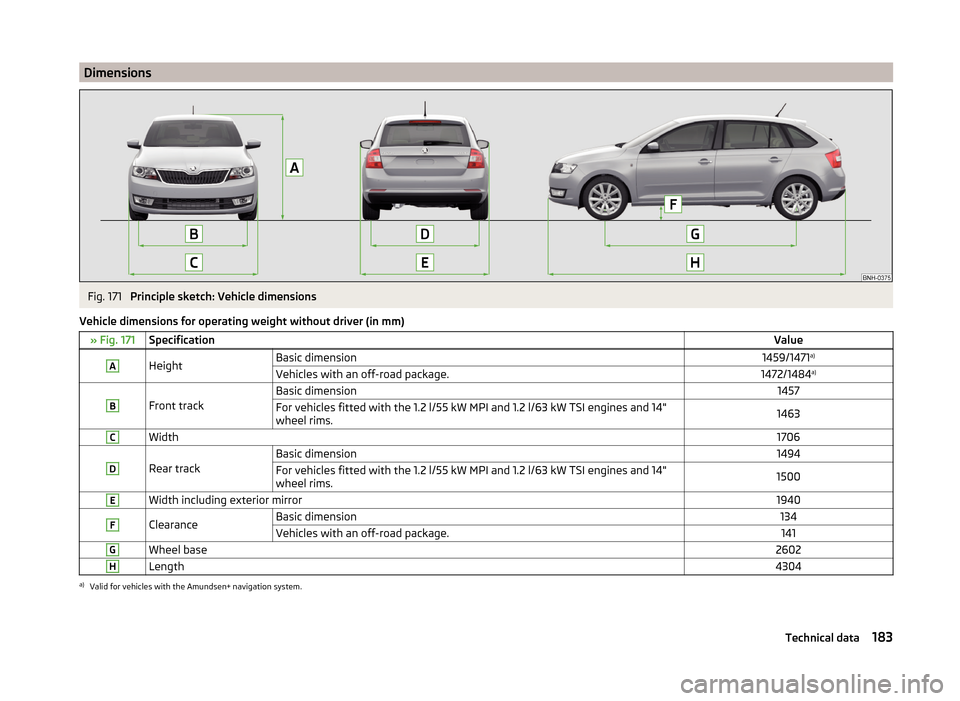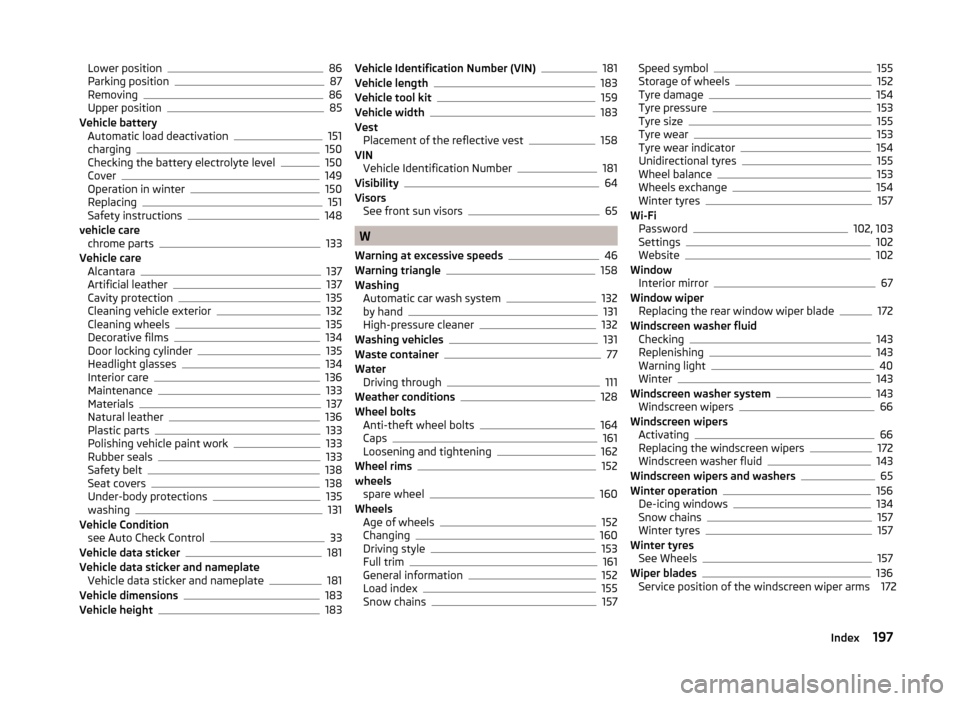width SKODA RAPID SPACEBACK 2014 1.G Owner's Manual
[x] Cancel search | Manufacturer: SKODA, Model Year: 2014, Model line: RAPID SPACEBACK, Model: SKODA RAPID SPACEBACK 2014 1.GPages: 204, PDF Size: 27.11 MB
Page 62 of 204

Switching on the parking light or parking lights1)
» page 63
Switch on low beam 1)
Pull switch Switch on the front fog lamp » page 61
Switching on the rear fog light » page 61
Headlight range control
Turning the dial B
» Fig. 39 from the position
in
means the headlight ad-
justment is gradually adjusted and thereby shortens the light cone.
The positions of the width of illumination correspond approximately to the fol- lowing car load.
Front seats occupied, boot empty
All seats occupied, boot empty
All seats occupied, boot loaded
Driver seat occupied, boot loaded
We recommend you adjust the headlight beam when the low beam is switched
on.
WARNINGAlways adjust the headlight beam to meet the following conditions.■The vehicle does not dazzle other road users, especially oncoming vehi-
cles.■
The beam range is sufficient for safe driving.
Note
■ An audible warning signal will sound if the light switch is in the or posi-
tion, the ignition key is removed and the driver's door is opened. The audible
warning signal is switched off after a few seconds or as a result of door con-
tact when the driver's door is closed. However, the side lights remain on to illu-
minate the parked vehicle if necessary.■
If leaving the vehicle without needing the parking lights on, always turn
the light switch to position
.
Daytime running lights(DAY LIGHT)
Read and observe
on page 58 first.
The daytime running lights (the only function) provides the lighting of the frontvehicle range.
The lights are switched on automatically if the following conditions are met. The light switch is in the position
or
» Fig. 39 on page 58 .
The ignition is switched on.
The parking aid is activated.
Deactivating the function
›
Switch off the ignition.
›
Remove the fuse for the daytime running lights » page 173, Fuses in the
dash panel .
Activating the function
›
Switch off the ignition.
›
Use a fuse of appropriate amperage for the daytime running
lights » page 173 , Fuses in the dash panel .
Disable function on vehicles with the START-STOP system or with the
automatic driving light control
›
Switch off the ignition.
›
Slide the turn signal light lever ( » Fig. 40 on page 60 ) downwards and hold
it in this position.
›
Switch on the ignition – wait until the left-turn signal light flashes 4x.
›
Switch off the ignition – an audible signal sounds which confirms the deacti-
vation of the function.
›
Release the turn signal stalk.
Function on vehicles with the START-STOP system or with the automatic
driving light control
›
Switch off the ignition.
›
Slide the turn signal light lever ( » Fig. 40 on page 60 ) upwards and hold it in
this position.
›
Switch on the ignition – wait until the right-turn signal light flashes 4x.
›
Switch off the ignition – an audible signal sounds which confirms the activa-
tion of the function.
1)
On vehicles with the instrument cluster - Version 1
» page 30 the symbol also illuminates on the light
switch.
59Lights and visibility
Page 73 of 204

Head restraints - adjusting heightFig. 53
Head rests: move up / move down
Read and observe
on page 69 first.
Adjustment of the head rest heights is the same in the front and rear.
Best protection is achieved if the top edge of the head rest is at the same level as the upper part of your head.
Move upwards
›
Push the headrest in the direction of arrow
1
» Fig. 53 .
Move downwards
›
Press the locking button
A
in the direction of the arrow
2
and
hold » Fig. 53 .
›
Push the headrest in the direction of arrow
3
.
WARNINGWith seats occupied, the respective head rests must be correctly set (may
not be in the bottom position) - there is a risk of fatal injury!
Note
For the sports seats, the head restraints are integrated into the front seat
backrests. This headrest cannot be adjusted in height.Headrests - removing and installingFig. 54
Front head rests: removal / installation
Fig. 55
Rear headrests: removal / installation
Read and observe
on page 69 first.
Front restraint
›
Pull the restraint out of the seat backrest as far as the stop.
›
Press the locking button
A
in the direction of arrow
1,
and pull the support
in the direction of arrow
2.›
To re-insert the head restraint, push it far enough down in the direction of
arrow
3
into the seat backrest until the locking button clicks into place.
Rear restraint
›
Pull the restraint out of the seat backrest as far as the stop.
›
Press the locking button
B
in the direction of arrow
4
, while at the same
time using a flat screwdriver with a max. width of 5 mm to press the securing button in opening
C
in the direction of arrow
5
.
›
Remove the restraint in the direction of arrow
6
.
70Using the system
Page 158 of 204

Unidirectional tyresRead and observe
on page 152 first.
The direction of rotation of the tyres is marked by arrows on the wall of the
tyre .
The indicated direction of rotation must be adhered to in order to ensure the
optimal characteristics of these tyres.
These characteristics mainly relate to the following.
› Increased driving stability.
› Reduced risk of aquaplaning.
› Reduced tyre noise and tyre wear.
Manufacturer-approved tyre variants
Introduction
This chapter contains information on the following subjects:
Explanation of the tyre labelling
155
Spaceback
156
Spaceback Green Line
156
Spaceback Green tec
156
Approved tyre variants are first to be selected for the model variant (e.g.
Spaceback GreenLine), and then selected according to the engine size of your
vehicle.
If the model variant of your vehicle cannot be found in the discrete module,
then the approved tyre variants are to be selected according to the engine size
of your vehicle in module » page 156, Spaceback .
Only use radial tyres of the same type, size (rolling circumference) and tread pattern on one axle on all four wheels.
When mounting new tyres the tyres have to be replaced axle by axle.
The information listed in the table corresponds to the information available at the time of going to press.
The approved tyre / rim combinations for your car are given on the sales and
technical vehicle documentation.
Explanation of the tyre labelling
Explanation of tyre markings
For example, 225/50R 17 91 T means:225Tyre width in mm50Height/width ratio in %RCode letter for the type of tyre – Radial17Diameter of wheel in inches91Load indexTSpeed symbol
The date of manufacture is stated on the tyre wall (possibly on the inside).
For example DOT ... 11 14... means, for example, that the tyre was manufac-
tured in the 11th week of 2014.
The marking M+Smeans that the associated tyre is suitable for winter use.
Load index
The load index indicates the maximum permissible load for each individual
tyre.
Load index838485868788Load
(In kg)487500515530545560
Speed symbol
The maximum speed symbol indicates the maximum permissible vehicle speed
with fitted tyres in each category.
Speed
symbolSTUHVWMaximum speed
(in km/h)180190200210240270WARNING■ Never exceed the maximum permissible load bearing capacity of moun-
ted tyres.■
Never exceed the maximum permissible speed for the mounted tyres.
155Wheels
Page 186 of 204

DimensionsFig. 171
Principle sketch: Vehicle dimensions
Vehicle dimensions for operating weight without driver (in mm)
» Fig. 171SpecificationValueAHeightBasic dimension1459/1471 a)Vehicles with an off-road package.1472/1484 a)B
Front track
Basic dimension1457For vehicles fitted with the 1.2 l/55 kW MPI and 1.2 l/63 kW TSI engines and 14"
wheel rims.1463CWidth1706D
Rear track
Basic dimension1494For vehicles fitted with the 1.2 l/55 kW MPI and 1.2 l/63 kW TSI engines and 14"
wheel rims.1500EWidth including exterior mirror1940FClearanceBasic dimension134Vehicles with an off-road package.141GWheel base2602HLength4304a)
Valid for vehicles with the Amundsen+ navigation system.
183Technical data
Page 200 of 204

Lower position86
Parking position87
Removing86
Upper position85
Vehicle battery Automatic load deactivation
151
charging150
Checking the battery electrolyte level150
Cover149
Operation in winter150
Replacing151
Safety instructions148
vehicle care chrome parts
133
Vehicle care Alcantara
137
Artificial leather137
Cavity protection135
Cleaning vehicle exterior132
Cleaning wheels135
Decorative films134
Door locking cylinder135
Headlight glasses134
Interior care136
Maintenance133
Materials137
Natural leather136
Plastic parts133
Polishing vehicle paint work133
Rubber seals133
Safety belt138
Seat covers138
Under-body protections135
washing131
Vehicle Condition see Auto Check Control
33
Vehicle data sticker181
Vehicle data sticker and nameplate Vehicle data sticker and nameplate
181
Vehicle dimensions183
Vehicle height183
Vehicle Identification Number (VIN)181
Vehicle length183
Vehicle tool kit159
Vehicle width183
Vest Placement of the reflective vest
158
VIN Vehicle Identification Number
181
Visibility64
Visors See front sun visors
65
W
Warning at excessive speeds
46
Warning triangle158
Washing Automatic car wash system
132
by hand131
High-pressure cleaner132
Washing vehicles131
Waste container77
Water Driving through
111
Weather conditions128
Wheel bolts Anti-theft wheel bolts
164
Caps161
Loosening and tightening162
Wheel rims152
wheels spare wheel
160
Wheels Age of wheels
152
Changing160
Driving style153
Full trim161
General information152
Load index155
Snow chains157
Speed symbol155
Storage of wheels152
Tyre damage154
Tyre pressure153
Tyre size155
Tyre wear153
Tyre wear indicator154
Unidirectional tyres155
Wheel balance153
Wheels exchange154
Winter tyres157
Wi-Fi Password
102, 103
Settings102
Website102
Window Interior mirror
67
Window wiper Replacing the rear window wiper blade
172
Windscreen washer fluid Checking
143
Replenishing143
Warning light40
Winter143
Windscreen washer system143
Windscreen wipers66
Windscreen wipers Activating
66
Replacing the windscreen wipers172
Windscreen washer fluid143
Windscreen wipers and washers65
Winter operation156
De-icing windows134
Snow chains157
Winter tyres157
Winter tyres See Wheels
157
Wiper blades136
Service position of the windscreen wiper arms 172
197Index